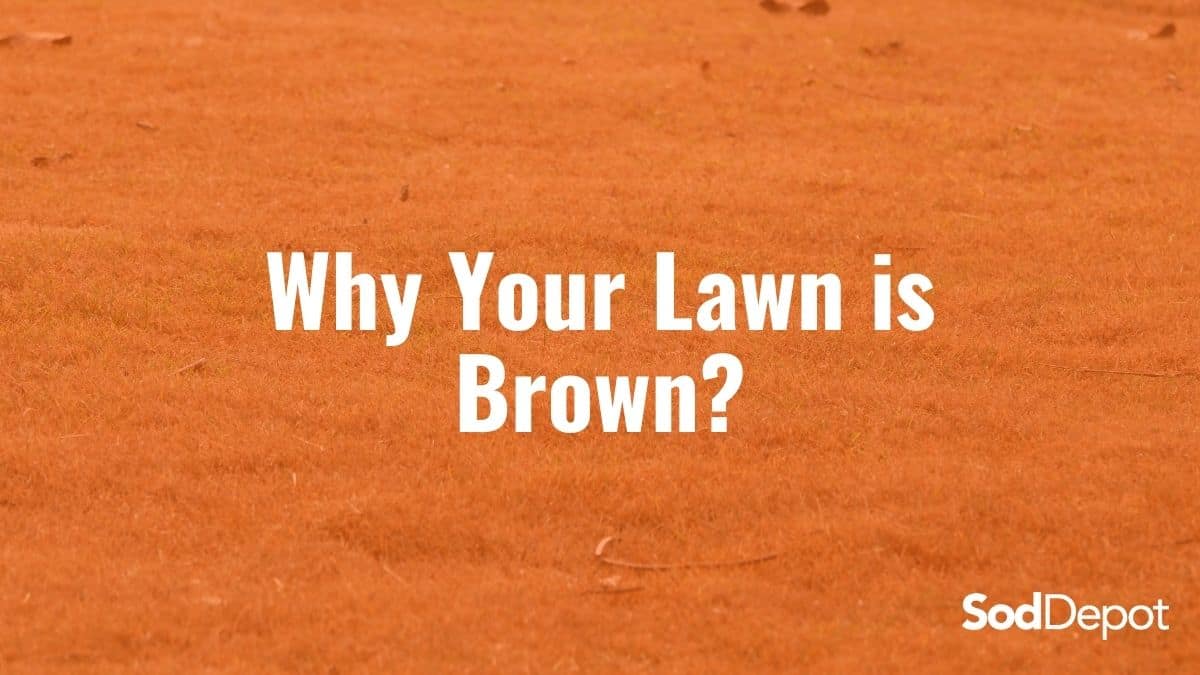Start your search and SAVE!! Dismiss
Why Your Lawn is Brown?

Your lawn is looking a little bit… brown. This can be a common thing that many homeowners will encounter.
There are several reasons why your lawn might be turning brown. Let’s take a look at the possible reasons.
Drought Stress
One of the most common causes of a brown lawn is drought stress. When your lawn doesn’t get enough water, it will start to turn brown.
Brown patches appear at random and in jagged patterns when drought is the cause. Lawn adjacent to a sprinkler head may be green, while grass further away becomes brown. Grassy areas under shade stay greener as sun-exposed portions of the lawn turn brown due to drought. Lawn in low locations will remain green, while higher regions will become brown.
A lawn that is stressed from drought will not recover even after receiving ample water, so you may need to replace the grass (or overseed it if you can)
Heat Stress
Excessive heat can also cause your lawn to turn brown. When temperatures reach 100 degrees or higher for an extended period of time, the grass will start to die.
You’ll usually see brown patches in circular or elliptical shapes. The grass will often be dry and brittle, and it may feel warm to the touch.
A lawn that is stressed from heat will not recover, so you may need to replace the grass (or overseed it if you can)
Fungal Disease
If your lawn is brown, it might be suffering from a fungal disease. There are several different types of fungus that can cause your lawn to turn brown.
The grass will start to die in patches and will often have a straw-like appearance. The roots may also become blackened and brittle.
Fungal diseases are often difficult to treat, so you may need to replace the grass (or overseed it if you can)
Insect Damage
If your lawn is brown, it might be because of insect damage. Insects such as sod webworms, billbugs, and chinch bugs will eat the grass blades, leaving behind brown patches.
The grass will often be dry and brittle, and the insects can be seen on the surface of the lawn.
Insect damage is often easy to treat, so you may only need to apply an insecticide to your lawn
Over-Fertilization
If your lawn is brown, it might be because you’re over-fertilizing it. When you over-fertilize your lawn, the grass will start to turn brown.
The grass will often be dry and brittle, and the tips of the blades will be yellow or brown.
Over-fertilization is easy to fix, so you’ll only need to stop fertilizing your lawn for a while
Lack of Fertilizer
If your lawn is brown, it might be because you’re not fertilizing it enough. When you don’t fertilize your lawn, the grass will start to turn brown.
The grass will often be dry and brittle, and the tips of the blades will be yellow or brown.
Lack of fertilizer is easy to fix, so you’ll only need to fertilize your lawn for a while.
Poor Drainage
If your lawn is brown, it might be because of poor drainage. When water doesn’t drain properly from your yard, it will start to kill the grass.
You’ll usually see brown patches in circular or elliptical shapes. The grass will often be wet and soggy, and it may smell bad.
Poor drainage is difficult to fix, so you may need to replace the grass (or install a drainage system)
Soil Compaction
If your lawn is brown, it might be because of soil compaction. When the soil is too compact, it won’t allow the grass to grow properly.
You’ll usually see brown patches in circular or elliptical shapes. The grass will often be dry and brittle, and you may see that the roots are growing sideways.
Soil compaction is difficult to fix, so you may need to replace the grass (or install a soil amendment)
Over-Watering
If your lawn is brown, it might be because you’re over-watering it. When you over-water your lawn, the grass will start to turn brown.
The grass will often be wet and soggy, and it may smell bad.
Over-watering is easy to fix, so you’ll only need to stop watering your lawn for a while
Shade
If your lawn is brown, it might be because it’s not getting enough sunlight. When the grass doesn’t get enough sunlight, it will start to turn brown.
You’ll usually see brown patches in circular or elliptical shapes. The grass will often be dry and brittle, and it may feel cool to the touch.
Shade is difficult to fix, so you may need to replace the grass (or move your lawn furniture)
Dormancy
Cool and warm-season grasses can both go dormant as a protective measure during periods of hot, arid weather. If the soil is wet enough, growth slows and the leaves stay green
When there isn’t any water to irrigate with, the grass turns brown. Don’t water it if the grass has turned brown; otherwise, you risk overwatering and causing root rot.
How Can You Help Your Brown Lawn?
So, what can you do to help your brown lawn? Water it regularly (but not too much), fertilize it, and treat it with an insecticide or fungicide as needed. By doing these things, you can help your lawn recover and return to its healthy green state.
If you’re having trouble identifying the cause of your brown lawn, it might be a good idea to call in a lawn professional. They can help you identify the problem and provide solutions to get your lawn back to its healthy state.
© Sod Depot – All Rights Reserved

